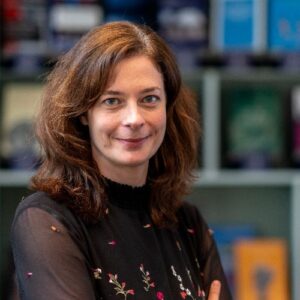This is the sixth post in a new series of perspectives from some of Publishing’s leaders across the non-profit and profit sectors of our industry. How did these leaders get into publishing? What excites them? What is their vision for the future of publishing, and indeed for the business and careers of all those working at their organization? We rarely gain these insights so we are excited to give voice to some of the key leaders in the academic publishing world.
Today, we talk to Jasmin Lange. Jasmin is Chief Publishing Officer at Brill in the Netherlands.
 What was your route into publishing?
What was your route into publishing?
As a 16-year-old I was two years into a side job as newspaper deliverer when a friend asked me whether I wanted to join the local book shop team. What a heavenly offer! Instead of schlepping newspapers through my hilly village regardless of rain and storm, I would be stacking shelves with the latest novels at much better pay. Working at a cozy small town bookshop was my introduction into the world of books, and I have been hooked ever since. After an internship and student job at an educational publisher, I finished a degree in Business Management and a PhD in Book History, a useful combination for being a publisher – and for nothing else. A move from the UK to the Netherlands 12 years ago brought me to Brill, where I climbed the career ladder from Assistant Editor to Chief Publishing Officer. An academic press feels like my natural habitat. It speaks to both my commercial and academic interests.
Could you tell our readers a little about what drives you as a leader of Brill?
Researchers are addressing today’s global challenges, from climate change to poverty. As publisher we play an important role in the creation and distribution of knowledge. This is one of the many reasons I love my job. In my role as CPO I facilitate a team of highly committed, smart and experienced editorial staff. We are here to support authors and editors in the important work they are doing. It’s easy to get out of bed each morning when this is your purpose.
As a leader in academic publishing, what most excites you right now?
Over the past centuries, academic publishers have set up an intricate, and constantly evolving infrastructure to serve research communities around the world. As a technology-driven business, academic publishing is in a continuous need for change. This makes our work so fascinating. Looking at the transformation process we are in now, we have the opportunity to significantly increase the level of equity, integrity and efficiency of scholarly communications. The transition to open access, push for SDGs and DEI, and the possibilities we have with automation, AI and machine learning will fundamentally change the way we evaluate, fund, and publish research.
What excites me most about these developments is what we can achieve together. I believe the key to making the system of scholarly communications stronger is in advancing collaboration between publishers, and with libraries, institutions, and funders. As board member of STM Solutions, I am enthused to see what can be accomplished in a short period of time for the greater good of everybody in the system. The STM Research Integrity Hub is a good example for a successful collaboration.
How is Brill positioned to serve the next generation of students, researchers and professionals?
Brill is a medium-size academic press with about 250 staff members. We publish mainly in the Humanities, Social Sciences, International Law, and Biology. My personal interest for innovation in the industry aside, a publisher like Brill should not jump onto every bandwagon, be it new software, new services, or new funder mandates. You can easily lose focus and forget what it is all about. Core to the development of our strategy is listening to the needs of librarians, partners, and authors. Early career researchers are one of the target groups we are especially working with. The feedback we receive from young scholars is vital: it informs our decisions on how and at what speed we change and transform our business.
We need to keep in mind that the foundation of our long-term success has been rather simple: the high quality and relevance of our publishing program, the strength of our networks, and the service we deliver to authors and editors. While expectations about services are changing, our highly recognizable brand, beautiful books and the personalized service – the human face of Brill — are the main reasons why both young and established authors come to Brill.
What do you anticipate the major challenges will be for Brill, and indeed the publishing industry, over the next five years?
The transformation we are in can increase the level of equity, integrity, and efficiency in scholarly communications, but there is no guarantee at all. Publishers will have to make significant investments to transform or exchange legacy systems, implement workflows geared towards new business models, and make sure the quality of the program we publish isn’t undermined by publication ethics violations. For small and medium-size publishers, it will be challenging to keep up with these developments. That’s why collaboration in the industry is key to safeguarding diversity.
What does open access (OA) mean for your business?
Knowledge is best shared openly, it’s the most impactful and our preferred mode of publishing research. The present-day reality in the fields we publish in, however, is a different one. While open access is by far the fastest growing business model, the vast majority of our revenues is still generated by paid access models such as subscription or outright purchase. We push to be more open, and we need to push harder to make sure the “openness gap” between Humanities/Social Sciences (HSS) and STM is not widening. Customers are increasingly aware of the negative impacts caused by the slower transition of HSS and are supportive of establishing sustainable models that work for all fields of research. This is a good development and Brill has benefited from this development in recent years. In 2023 we will get close to having published 1,200 gold OA books; what our small OA team has achieved together with our editorial department, makes me very proud.
What publishing innovations are you most proud of?
A few years ago, Brill set out on a path to develop its own typeface, “The Brill”, together with font designer John Hudson. Brill has always been an expert in typesetting non-Western script. However, the specialized nature of the texts we published often collided with the limitations of available fonts. “The Brill” resolved this problem: it has all the tools that are necessary to cleanly display even the most complex aspects of scholarly texts in a sophisticated way. Developing a specialized font is a good example of the kind of innovation that fits the size and type of publishing house we are. Development costs were covered by higher printing efficiency, we made use of our inhouse expertise, and addressed the specific needs of our community. A niche innovation, but very much in the tradition of the publishing excellence Brill stands for. Very recently, “The Brill” was licensed by Apple, which feels a little bit like a knighting for the team responsible for this innovation.
While we tend to speak of our successes, our failures are often more intense learning experiences. Let me give you an example. Together with a group of committed scholars, we have tried to develop handwriting recognition software as a service. It was a great idea, because we publish a sizable collection of primary sources, and it worked in an academic setting. In the end though, the idea was not scalable as a commercial product. Yes, it is disappointing if a costly project doesn’t deliver what you were hoping for. However, I personally have learned a lot from this experience, and as a team we realized and recognized our limits and shortcomings and will make better investment decisions next time.
What is the future of hybrid/remote working at Brill?
The future of work at Brill is flexible and hybrid. During the pandemic we had good experiences with staff working from home or elsewhere. In March 2020, we quickly implemented Teams to connect and collaborate, and we organized online activities like virtual yoga sessions or bingo games. Small moments of engagement with our colleagues were important for our employee satisfaction and productivity during this challenging period. While the overall experience was good, we also learned that full-time remote working can have negative consequences for team dynamics and for the well-being and mental health of staff.
As of recently, we meet again regularly at the office for moments of coaching, mentoring, idea sharing, and coworking. We will continue to invest in our remote working capabilities as the digital environment is just as important as a welcoming office space. As an employer we feel an increased responsibility to make sure there is a healthy balance between work and private life, and we probably reach out more regularly to ask colleagues about their well-being, regardless of whether they work at home or in the office.
What do the next generation of academic publishing jobs look like to you?
I am sure we will have more specialized roles in areas such as technology. At the same time, there is a continued need for generalists who build bridges both internally and for our customers. For the generalists in Sales and Publishing, it will remain important to have a strong commercial and academic foundation but also an interest in and an understanding of technology.
I am convinced that Publishing will remain a people business. The scholars we work with are highly committed, passionate individuals who invest all of their time and efforts into this one journal article, this one book. We can automate a lot, a lot more than we already do, but we need to make sure we continue to put the fantastic scholars we work with at the center of what we do and keep on building the relationships that have strengthened us in the past.
Discussion
1 Thought on "Chefs de Cuisine: Perspectives from Publishing’s Top Table — Jasmin Lange"
I’m impressed to read about “The Brill” font and intrigued on your mention of higher printing efficiency. Is that more digital short run and POD?

